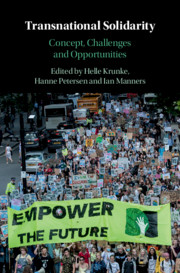Book contents
- Transnational Solidarity
- Transnational Solidarity
- Copyright page
- Contents
- Figures
- Tables
- Preface
- Introduction
- Part I Transnational Solidarity
- Part II Transnational Solidarity in Europe
- Part III (Re)Establishing Transnational Solidarity Within Existing European Institutions and Political Settings
- 11 Postnational European Democracy
- 12 Solidarity in the Case Law of the European Court of Justice
- 13 Civic Solidarity in Transnational Spaces
- Part IV Creating New Forms of Transnational Solidarity in Europe
- Index
13 - Civic Solidarity in Transnational Spaces
Organisation and Institutionalisation of Solidarity Within the European Union
from Part III - (Re)Establishing Transnational Solidarity Within Existing European Institutions and Political Settings
Published online by Cambridge University Press: 04 July 2020
- Transnational Solidarity
- Transnational Solidarity
- Copyright page
- Contents
- Figures
- Tables
- Preface
- Introduction
- Part I Transnational Solidarity
- Part II Transnational Solidarity in Europe
- Part III (Re)Establishing Transnational Solidarity Within Existing European Institutions and Political Settings
- 11 Postnational European Democracy
- 12 Solidarity in the Case Law of the European Court of Justice
- 13 Civic Solidarity in Transnational Spaces
- Part IV Creating New Forms of Transnational Solidarity in Europe
- Index
Summary
European solidarity has become a focal point of discussion in the recent decades. This chapter takes a closer look at European solidarity and develops a conceptual framework that distinguishes between different levels of aggregation and institutionalisation, namely informal citizens’ networks, organised civil societies and welfare states. The EU furnishes an instructive case because solidarity is organised and institutionalised in a more fragmented manner, when compared to the nation state. The chapter engages in a discussion of the implications of this peculiar situation, by presenting data about transnational solidarity by citizens’ groups and civil society organisations. The empirical findings show that civic initiatives and organisations across Europe are actively engaged in supporting troubled groups, and that the organisational field reacts to upcoming crises and grievances. At the same time, however, European civic solidarity exhibits moments of fragmentation, fragility and volatility, given the limitations of its institutional context.
- Type
- Chapter
- Information
- Transnational SolidarityConcept, Challenges and Opportunities, pp. 301 - 324Publisher: Cambridge University PressPrint publication year: 2020
- 2
- Cited by

